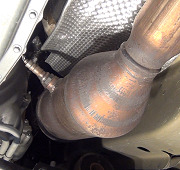Ford should reset it for you, Emeissions are covered for 8 years 80,000 miles, and they can reset it with WDS tool. Here's the scoop on I/M Readines I also sent a PDF by email.
NOTE: The following procedure is designed to execute and complete the evaporative emission repair verification drive cycle and to clear the Ford P1000, inspection and maintenance (I/M) readiness code. When the ambient air temperature is below 4.4 °C (40 °F) or above 37.8 °C (100 ° F), or the altitude is above 2,438 meters (8,000 feet), the evaporative emission (EVAP) monitor will not run. If the P1000 must be cleared in these conditions, the powertrain control module (PCM) must detect them once (twice on some applications) before the EVAP monitor can be bypassed and the P1000 cleared. The EVAP bypassing procedure is described in the following drive cycle. Drive cycle recommendations Most OBD II monitors will complete more readily using a steady foot driving style during cruise or acceleration modes. Operating the throttle in a smooth fashion will minimize the time necessary for monitor completion. 1. Fuel tank level should be between one-half and three-quarters full, with three-quarters full being the most desirable. 2. The evaporative monitor can only operate during the first 30 minutes of engine operation. When executing the procedure for this monitor, stay in part throttle mode and drive in a smooth fashion to minimize fuel slosh. 3. NOTE: For best results, follow each of the following steps as accurately as possible. Drive cycle preparation NOTE: This step bypasses the engine soak timer and resets OBD II monitor status. Install the diagnostic tool. Turn the key ON with the engine OFF. Cycle the key OFF, then ON. Select the appropriate vehicle and engine qualifier. Clear all diagnostic trouble codes (DTCs) and reset the PCM. 4. Begin to monitor the following PIDs: ECT, EVAPDC, FLI (if available) and TP MODE. Press Diagnostic Data Link, PCM, PID/Data monitor and record, press trigger to select each PID, then start. 5. Start the engine without returning the key to the OFF position. 6. WARNING: Strict observance of posted speed limits and attention to driving conditions are mandatory when proceeding through the following drive cycle. Preparation for monitor entry NOTE: This step allows engine warm-up and provides intake air temperature (IAT) input to the PCM. Idle the vehicle for 15 seconds. Drive at 64 km/h (40 mph) until the ECT is at least 76.7 °C (170 °F). 7. The IAT should be between 4.4 °C (40 °F) and 37.8 °C (100 °F). If not, continue with the following steps, but note that the EVAP monitor bypass portion of the drive cycle (Step 13) will be required to bypass the EVAP monitor and clear the DTC. 8. NOTE: The purpose of this step is to monitor the heated oxygen sensor (HO2S). Cruise at 64 km/h (40 mph) for 60 seconds. 9. NOTE: This step is used to monitor the EVAP if IAT is above 4.4 °C (40 °F) and below 37.8 °C (100 °F). NOTE: To initiate the monitor, TP MODE should equal PT, EVAPDC must be greater than 75%, and FLI must be between 15 and 85%. NOTE: Avoid sharp turns and hills. Cruise at 72 to 104 km/h (45 to 65 mph) for 10 minutes. 10. NOTE: This step tests the idle speed control of the (ISC) portion of the Secondary Air/CCM. Bring the vehicle to a stop. Idle with the transmission in DRIVE (for automatic transmission) or NEUTRAL (for manual transmission) for 2 minutes. 11. Pending code and EVAP monitor bypass check NOTE: This determines if a pending code is preventing DTC P1000 from clearing. NOTE: If the EVAP monitor is not complete and IAT was below 4.4 °C (40 ° F) or above 37.8 °C (100 °F) temperature range in Step 8, or the altitude is above 2,438 meters (8,000 feet), the EVAP monitor bypass (Step 13) must be carried out. Using the diagnostic tool, check for pending codes. Conduct normal repair procedures for any pending code concerns. Rerun any incomplete monitor. 12. EVAP monitor bypass NOTE: This allows the bypass counter to increment to 2. Park the vehicle for a minimum of 8 hours. Repeat Steps 5 through 12. 13.
Sunday, January 10th, 2010 AT 3:06 AM



